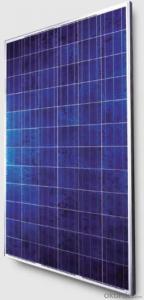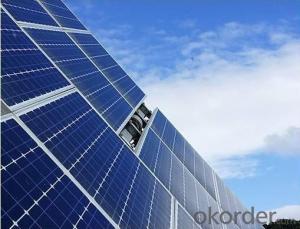Spray Paint Solar Cells - CNBM PV Silicon Modules Made in China for Overseas Market
- Loading Port:
- Shanghai
- Payment Terms:
- TT OR LC
- Min Order Qty:
- 1 pallet
- Supply Capability:
- 100000000 pallet/month
OKorder Service Pledge
OKorder Financial Service
You Might Also Like

Specifications:
solar panels from 5W--300W, made of TAIWAN MOTECH brand cells,with CO in TAIWAN,Mono and Poly with VDE,IEC,CSA,UL,CE,ISO.
We import solar cells from Taiwan Motech brand, with this CO in taiwan and our CSA certification,we can still sell goods to Anti-dumping areas like USA. Our main products are solar panels, off grid and on grid solar home systems , solar street lighting systems, solar water heating system,solar pump,solar attic fan, solar DC LED lights and solar DC refrigerators.
Certificates : ISO, CE, VDE IEC, MCS, CSA-UL, CEC.
Delivery time: sample 10days, order 25-30days.
Sample: charged.
Payment term: T/T 30% as deposit, 70% before shipment. Or irrevocable L/C at sight.
Trade term: FOB Shenzhen or CIF destination seaport or Airport.
Characteristics:
I.Solar Cell : High efficiency crystalline solar cell. Even if under the weak light, the solar module can produce maximum power output.
II.Tempered glass (toughened glass): Anti-reflecting coating and high transmission rate glass increase the power output and mechanical strength of solar module.
III.EVA and TPT: Using high quality EVA and TPT to prevent destroying and water.
IV.AI frame: Without screw, corner connection. 6 holes on the frame can be installed easily.
V.Junction box: Multi function junction box with water proof.
VI.Long lifetime: ≥25 years; Less power decrease.
VII.Good performance of preventing from atrocious weather such as wind and hails.
VIII.Resisting moisture and etching effectively, not effected by geology.
IX.The certificate issued by international authority: UL, TUV, IEC, VDE, CE.
Quality and Safety
1. Rigorous quality control meets the highest international standards.
2. High-transmissivity low-iron tempered glass, strong aluminium frame.
3. Using UV-resistant silicon.
4. IS09001/14001/CE/TUV/UL
Warranties
1. 10 years limited product warranty
2. 15 years at 90% of the minimal rated power output
3. 25 years at 80% of the minimal rated power output
Technical date :
ITEM NO.: | Poly 156*156 cell ,60pcs . Power range from 230Wp-260Wp | ||||||
Maximum Power(W) | 230 | 235 | 240 | 245 | 250 | 255 | 260 |
Optimum Power Voltage(Vmp) | 29.4 | 29.5 | 29.7 | 30.1 | 30.3 | 30.5 | 30.7 |
Optimum Operatige Current(Imp) | 7.83 | 7.97 | 8.08 | 8.14 | 8.25 | 8.37 | 8.48 |
Open Circuit Voltage(Voc) | 36.7 | 36.8 | 36.9 | 37.1 | 37.3 | 37.5 | 37.7 |
Short Circuit Current(Isc) | 8.52 | 8.59 | 8.62 | 8.65 | 8.69 | 8.73 | 8.78 |
Solar Cell: | 156*156 Poly | ||||||
Number of Cell(pcs) | 6*10 | ||||||
Name of Solar Cells | Polycrystalline Cell | ||||||
Size of Module(mm) | 1650*992*40/45/50 | ||||||
Cable & Connector Type | Pass the TUV Certificate | ||||||
Frame(Material Corners,etc.) | Aluminium-alloy | ||||||
Back sheet | TPT | ||||||
Weight Per Piece(KG) | 19.5KG | ||||||
FF (%) | 70-76% | ||||||
Junction Box Type | Pass the TUV Certificate | ||||||
Tolerance Wattage(e.g.+/-5%) | ±3%, or 0-3% | ||||||
Front Glass Thickness(mm) | 3.2 | ||||||
Temperature Coefficients of Isc(%) | +0.04 | ||||||
Temperature Coefficients of Voc(%) | -0.38 | ||||||
Temperature Coefficients of Pm(%) | -0.47 | ||||||
Temperature Coefficients of Im(%) | +0.04 | ||||||
Temperature Coefficients of Vm(%) | -0.38 | ||||||
Temperature Range | -40°C to +85°C | ||||||
Surface Maximum Load Capacity | 5400Pa | ||||||
Allowable Hail Load | 23m/s ,7.53g | ||||||
Bypass Diode Rating(A) | 12 | ||||||
Warranty | 90% of 10 years, 80% of 25 years. | ||||||
Standard Test Conditions | AM1.5 1000W/ 25 +/-2°C | ||||||
Packing | carton or pallet | ||||||
1*20' | 14 Pallets / 316pcs | ||||||
1*40'STD | 25 Pallets / 700pcs | ||||||
FAQ:
We have organized several common questions for our clients,may help you sincerely:
1. What’s price per watt?
A: It’s depends on the quantity, delivery date and payment terms of the order. We can talk further about the detail price issue. Our products is high quality with lower price level.
2. Can you tell me the parameter of your solar panels?
We have different series of cells with different power output, both from c-si to a-si. Please take our specification sheet for your reference.
3. How do you pack your products?
We have rich experience on how to pack the panels to make sure the safety on shipment when it arrives at the destination.
4. Can you do OEM for us?
Yes, we can.
5. How long can we receive the product after purchase?
In the purchase of product within three working days, We will arrange the factory delivery as soon as possible. The perfect time of receiving is related to the state and position of customers. Commonly 7 to 10 working days can be served.
- Q: How do solar cells generate electricity?
- Solar cells generate electricity through the photovoltaic effect, where the cells convert sunlight directly into electrical energy. The cells are made of semiconducting materials, usually silicon, which absorb photons from the sunlight. These photons excite the electrons in the material, causing them to break free from their atoms and create an electric current. This current is then collected and used to power various devices or stored in batteries for later use.
- Q: Can solar cells be used in remote or inaccessible locations?
- Yes, solar cells can be used in remote or inaccessible locations. Solar cells are a reliable and sustainable source of energy that can be installed in areas with limited infrastructure or access to the grid. They are often used to power remote buildings, off-grid communities, and even in space missions. The portability and versatility of solar panels make them an ideal solution for providing electricity in remote or inaccessible locations.
- Q: How do solar cells perform in dusty environments?
- Solar cells perform less efficiently in dusty environments due to reduced sunlight reaching the surface of the cells. Dust particles can accumulate on the surface of the solar panels, blocking the sunlight and reducing the amount of energy that can be converted. Regular cleaning and maintenance are necessary to ensure optimal performance in dusty conditions.
- Q: Can solar cells be used to power water treatment plants?
- Yes, solar cells can be used to power water treatment plants. Solar energy can be harnessed by installing photovoltaic panels, which convert sunlight into electricity. This renewable energy source can provide a sustainable and cost-effective solution for powering water treatment plants, reducing dependence on fossil fuels and minimizing environmental impact.
- Q: How do solar cells perform in areas with high levels of pollen?
- Solar cells can be affected by high levels of pollen as it can accumulate on the surface, reducing their efficiency. Regular cleaning and maintenance of the solar panels can help mitigate the impact of pollen and ensure optimal performance in areas with high pollen levels.
- Q: How do solar cells handle electromagnetic radiation?
- Solar cells are designed to handle electromagnetic radiation by converting it into usable electrical energy. The materials within the solar cells absorb photons from the sunlight, which in turn generates an electric current. This process effectively harnesses the energy from the electromagnetic radiation and allows solar cells to produce clean and renewable electricity.
- Q: Can solar cells be used in harsh climates?
- Yes, solar cells can be used in harsh climates. Solar cells are designed to withstand extreme weather conditions, including high temperatures, cold temperatures, and strong winds. They are often tested and certified to meet specific durability and performance standards, ensuring their reliability in harsh climates. Additionally, advancements in solar technology have led to the development of specialized solar panels that are specifically designed to perform well in extreme weather conditions, such as snow, hail, and sandstorms.
- Q: What is the average lifespan of a solar cell in space?
- The average lifespan of a solar cell in space can vary depending on several factors, such as the quality of the materials used, exposure to radiation, and maintenance. Generally, solar cells in space are designed to last anywhere from 10 to 25 years, but some have been known to continue functioning well beyond that timeframe.
- Q: Can solar cells be used for telecommunications infrastructure?
- Yes, solar cells can be used for telecommunications infrastructure. Solar cells can generate electricity from sunlight, making them an ideal renewable energy source for powering remote telecommunications towers, base stations, and other infrastructure. They can provide a reliable and sustainable power supply in areas where grid electricity is unavailable or unreliable, reducing dependence on fossil fuels and minimizing operational costs.
- Q: Are solar cells safe for the environment?
- Yes, solar cells are safe for the environment. They generate electricity by converting sunlight into clean energy, emitting no greenhouse gases or air pollutants during operation. Additionally, the production and installation of solar cells have minimal environmental impact compared to conventional energy sources.
Send your message to us
Spray Paint Solar Cells - CNBM PV Silicon Modules Made in China for Overseas Market
- Loading Port:
- Shanghai
- Payment Terms:
- TT OR LC
- Min Order Qty:
- 1 pallet
- Supply Capability:
- 100000000 pallet/month
OKorder Service Pledge
OKorder Financial Service
Similar products
Hot products
Hot Searches
Related keywords




























